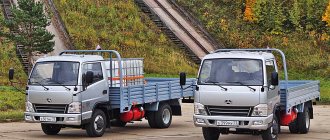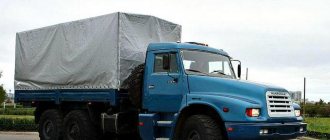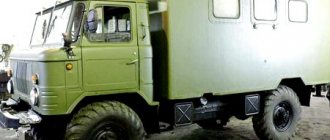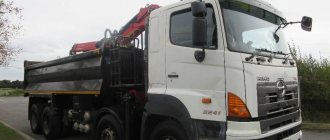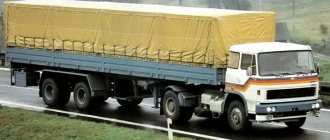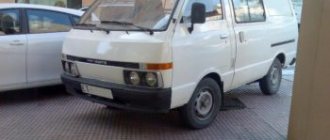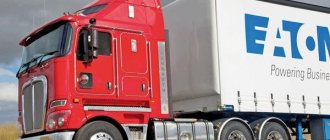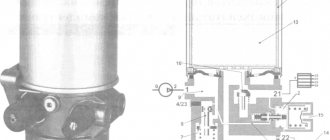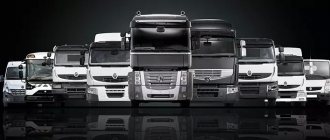Andrey Mikhailov, photo by the author
Import substitution in today's Russia is not a tribute to fashion, but an urgent necessity. The instability of exchange rates makes everyone think about how to competently replace goods purchased for foreign currency with analogues of domestic origin. The “Chinese camp” found an unexpected solution to this problem: the BAW company showed journalists its new product – the BAW-33462-102 light truck with a ZMZ gas engine.
In the ten years that the BAW brand has been represented in Russia, a lot of water has passed under the bridge. Dozens of Chinese companies entered the arena and disappeared, which, having not mastered the conquest, stopped supplies. In contrast, BAW, which has established itself through joint production in Ulyanovsk, not only confidently continues its presence, but also introduces new models developed in Russia.
The manufacturer himself suggests that the new product will be of interest to private entrepreneurs and small firms, where the cost of owning a truck, as well as its low starting price, is especially relevant. According to Andrey Lukyanov, General Director of BAU-RUS Motor Corporation, the idea of creating a gas-cylinder truck arose at the enterprise back in 2013. At the same time, it was important that the total weight of the truck did not exceed 3.5 tons in order to “fit” it into category B, and that the vehicle itself was affordable, durable and simple.
Chinese with Nizhny Novgorod
While the plant itself was undergoing technical re-equipment, the engineering corps was working on a new gas product. Having tried many options, it was decided to settle on a very unexpected one - the place in the engine compartment of the BAW-33462-102 was taken by an engine from the Volga region, model ZMZ-409061.10. It runs on liquefied petroleum gas or, more simply put, propane. At the time of development, the Volga residents did not have a ready-made solution for the required engine to meet the Euro 5 eco-standard, so they customized it on the order of the Ulyanovsk residents “outsourced”. The ITELMA industrial holding helped, which also became the supplier of the MIKAS 12 electronic control unit for the Russian-Chinese truck. The manufacturer assures that as a result, the gas engine has become 7% more powerful than its gasoline counterpart.
For the test drive, which took place at the Dmitrovsky test site, the manufacturer provided two BAW-33462-102 with different options for cargo platforms: for 6 and 8 Euro pallets, respectively. The vehicle with the larger platform was additionally loaded with 1,700 kg of ballast until fully loaded, so that the behavior of both the empty and loaded truck could be compared.
It would seem that all Asian trucks are made according to the same recipe: a cabover cab “on horseback” on the front axle, the engine is under the cab; at the back there is a large side platform.
BAW-33462-102 is no exception to this rule: it is easy to recognize the features of one of the “Japanese” cars of the nineties, which are often found on our roads today. It is typical for “Asians” - both Chinese, Korean, and Japanese trucks - that the battery hanging on the frame on the right, behind the cab, is open to all winds and prying eyes. Next to the battery is a small, only 15 liter, tank for 92-grade gasoline: on a gas car it is only needed for cold starting and warming up, so there was no need for a full tank.
On the left side is a cylinder for propane-butane: gas equipment for the Ulyanovsk enterprise is supplied by the Italian company LOVATO, well known to those who operate propane vehicles. The gas cylinder with a volume of 95 liters, installed on the truck, was produced by a Russian company based in Moscow.
BAW PHOENIX. "State employee" on gas
In Russia, the production of trucks of the Chinese BAW brand, adapted to operate on cheap petroleum gas, has been launched. The manufacturer promises significant savings on fuel - we found out whether this is actually true
Sergey Zhukov
BAW 33462-102 FENIX. Gross weight: 3500 kg. Start of sales: summer 2015 Price: from 780,000 rub.
The assembly of Chinese BAW brand trucks was organized in Ulyanovsk in 2006. At that time it was exclusively a “screwdriver” assembly. In 2010–2011 a decision is made to begin localization and organize joint production. The reason was the poor-quality painting of cabins supplied from China. And this despite the fact that it was neither logistically nor economically profitable for the company to engage in a localization program. Then everything on the market went, as they say, “in flight.” But there was one more aspect that encouraged us to move forward: the market required a car with different characteristics. Which, in fact, is what the company did.
The interior of the BAW 33462-102 cabin can be called typical of all Chinese trucks: cheap and cheerful. Fortunately there are no foreign odors...
To date, BAU-RUS Motor Corporation has a production of trucks with more than 60% localization for individual models. Welding and painting of cabins, full assembly of chassis and trucks themselves, as well as the production of vans and buses are carried out here. It was precisely this highly localized truck, which is the new product, that we were introduced to at the Dmitrovsky training ground in September of this year.
So, BAW 33462-102 Fenix. The start of design work dates back to 2013. The main parameter included in the design of the vehicle was the cost of owning a truck. In order to achieve the design indicators, it was decided to develop a car adapted to run on liquefied gas.
The entrance is convenient. Steering column with two degrees of adjustment
Initially, different options for power units were considered, of which there were as many as 15, including European, Russian, Chinese and even Indian models. However, the developers chose the domestic ZMZ engine. The factors that influenced this choice were: the only motor in its class with a fairly modern design; use of overhead valve timing in engine design; the presence of a sufficiently rigid cast iron block. Perhaps the only significant disadvantage is the lack of an option with Euro-5.
Since in 2013 the developers did not have time to certify this motor in Euro-4 performance, it was decided to immediately work on creating a motor that meets Euro-5 requirements.
The developers had to go through a rather thorny path to fine-tune the engine. However, thanks to the efforts of Russian engineering, the work was crowned with success. For about 8 months, the engine was first refined on bench tests, then on an assembled car.
The battery, of course, would be nice to place in a protective casing, taking into account our operating conditions
As already noted, the engine was originally designed to run on gas. At the same time, it was possible to obtain 7% more power and torque compared to the basic version. The engine is started on gasoline, when the temperature reaches 45–50 °C, only gas is used as fuel. The electronic engine control system is also of domestic production. For a number of reasons, gas equipment made in Italy by Lovato is used. The declared engine resource is 250 thousand km.
If we continue the topic of components, it turns out that the degree of localization of the BAW 33462-102 Fenix truck today is 63%. In addition to the power unit, the car is equipped with a Russian exhaust system, electrical equipment, lighting, ventilation and heating systems, glass, mirrors, superstructure elements and other domestic components.
Next year, BAU-RUS Motor Corporation plans to increase the localization level to 82%. The truck, in particular, will have new springs, shock absorbers, a driveshaft, and steering rods. Negotiations are underway to install GAZ Group gearboxes, front and rear axles on Ulyanovsk trucks.
Continuing the conversation about the new product, we note the presence of specially selected gear ratios in the gearbox and rear axle, which lighten the load on the transmission of a loaded vehicle.
Access to the main engine systems should be considered normal. Recline the cabin and have fun
The riveted U-shaped frame has a high load-bearing capacity. The rear 7-leaf spring suspension provides the required parameters for a smooth ride both empty and loaded. Among the controversial points, it should be noted the presence of footers in the rear wheel mounts. At the same time, when moving to the “Gazovsky” bridge, this problem will disappear by itself.
The carrying capacity of the machine with an onboard platform is 1700 kg. At the same time, the dimensions of the standard onboard platform (4245x1905 mm) allow the transportation of up to 6 europallets, long and oversized cargo. It is also possible to install a wider platform (4245x2060 mm), which can accommodate up to 8 Euro pallets.
It so happens that we talk about the cabin at the end of the descriptive part of the truck. It is typical for Chinese trucks in this segment. Two people can be accommodated here quite comfortably. Along the way, it is worth noting a good driver’s seat, with a sufficient number of adjustments, the presence of a tilt- and reach-adjustable steering column, and power window servo drives.
We must pay tribute to the organizers of the event; they prepared two cars for acquaintance - empty and loaded, which does not happen as often as we would like.
The empty car confidently held the road. The engine speed did not exceed 2500 rpm. In fifth gear it was quite possible to overcome a long climb. No strong “goatiness” was noticed.
The loaded car also left a good impression. Engine speed increased to 3000 rpm. But traction capabilities remained at an acceptable level. According to the developers, their truck is capable of driving at full load at speeds of up to 120 km/h, while the engine speed will not exceed 4000 min-1. The only thing I would like to advise the developers is to install a stabilizer bar on the rear axle. With a voluminous load, the roll in turns would not be so great.
By the way, the box, as an example to other “Chinese” ones, is quite adequate. This is exactly what is the sore spot of many commercial vehicles from China.
When asked how long a 15-liter gasoline tank is enough to start a gas engine, an evasive answer was received, the essence of which was that it needs to be increased to 20 liters. The consumption of liquefied gas in the combined cycle is stated at 15 l/100 km. However, this only applies to those cases when refueling is carried out at “civilian” gas stations. Practice has shown that if you fill up anywhere, you can get all 30.
50 cars from the pilot batch have already found their consumers. Plans for this year include releasing the same number. The warranty period is 3 years or 100 thousand km, whichever comes first. A service interval of 10 thousand km should be considered quite small in modern times.
With a large platform, extended mirrors provide the required visibility
The declared cost of ownership, the lowest in its class, in the amount of 5.37 rubles/1 km, will be left to the manufacturer’s conscience.
What's next? The appearance next year of a modification with a diesel engine, also from ZMZ - the 514th engine. Creation of a modification to operate on compressed gas (methane). Since the company assembles buses in small batches, next year a bus with a dual-fuel (diesel-methane) power unit, created in collaboration with Lovata, is expected to appear. In the meantime, options for using Deutz and Cummins engines are being considered.
A 15-liter gasoline tank is clearly not enough, especially in winter
And finally, in connection with the new strategy in 2015, a decision was made to change the brand. First of all, this is due to the fact that the cars produced are already Russian in all respects. A new brand is at the registration stage. At the same time, cars with diesel engines will remain with the proper name Fenix, cars equipped with gasoline power units will receive the name Pegas.
- Budget, unpretentious truck for working on liquefied petroleum gas at an affordable price
- The use of footers in securing the rear wheels, the absence of a stabilizer bar on the rear axle
| Specifications | |
| Wheel formula | 4x2 |
| Curb weight, kg | 1800 |
| Total weight, kg | 3500 |
| Fuel tank volume, l | 95 (gas) + 15 (petrol) |
| Engine | |
| type | gas with spark ignition, 4-cylinder, Euro-5 |
| working volume, cm3 | 2693 |
| power, l. With. at min-1 | 136 at 4200 |
| torque, Nm at min-1 | 214 at 4000 |
| Transmission | mech., 5-speed |
| Suspension | dependent, spring |
| Brakes | |
| front | disk |
| rear | drums |
| Tire size | 225/75R16C |
| Price | |
| Basic, rub. | from 780 000 |
| Service | |
| Factory warranty | 3 years or 100,000 km |
| Mileage between services, km | 10 000 |
| Competitors | |
| FAW CA1041, GAZ-33025-244 "GAZelle BUSINESS" | |
The editors recommend:
Why do piston rings stick and how to prevent it?
A traffic police officer searched my car: did he have the right to do so?
Russians may be left without foreign cars: Western automakers have stopped supplying cars to our country
A ship that was transporting cars to Russia was detained in France
Half of the car factories in Russia have closed
News Media2
Discussion Cancel
Inner world
The driver's seat greets you with two news: good and not so good. The good news is that you can get relatively comfortable behind the wheel: the driver’s seat is adjustable longitudinally and for backrest tilt (although you have to search for a long time for the longitudinal adjustment lever under the seat), and the steering column is adjustable for reach and tilt. The bad news is that the position remains unnatural due to the strange pedal assembly: if you are not used to it, there is a risk of pressing the gas and brake pedals at the same time. Drivers who brought cars from the factory refer to the fact that they did not have time to “bend the pedal”, supposedly there is room for improvement; however, it is better to find a solution to the problem by the manufacturer himself in order to avoid “on-site” experiments in the future.
The two passenger seats are much simpler in shape and not as comfortable. The main feature is the folding backrests: the middle seat has a lockable storage compartment, a paper tray and two cup holders, and the outer seat on the right can be folded if there is a need to sleep in the cabin.
The interior is made of simple materials, which is quite forgivable in a cheap car. At the same time, which is uncharacteristic for the “Chinese”, the finishing materials in BAW do not greet the cabin with a pungent chemical aroma - this is a noticeable step forward relative to its fellow competitors. The instrument cluster looks modest, but not bad: large dials for the speedometer and tachometer, between them there is a block of indicator lamps and a display that displays the odometer and power reserve.
An unpleasant little thing is that the glove box and pockets in the doors are too small for documents of forwarders and drivers, so the papers are carried behind the driver’s visor. The new BAW, with its gray plastic modesty, stands out positively from its relatives, where the interior greets with a strong chemical aroma and plastic wood veneer. The issue of ventilation in the cabin was solved in a rather original way: a small lifting hatch was made in the roof, adjustable with a “twist” on the ceiling.
There is no access to the engine compartment from the cab: to perform most simple operations, the cab will need to be raised using a pair of levers behind it. Except that a couple of tanks with technical fluids are modestly located under the edges of the instrument panel. Their filler necks are covered with decorative caps in the panel, which will soon be lost - they are not secured by anything and will need to be held in your hands when refilling.
Let's talk our way
The empty BAW that I got is surprisingly nimble for a gas car: it accelerates confidently, the gears are engaged unexpectedly for a “Chinese” clearly, and it confidently goes up hills in both IV and V gears. The car itself, thanks to the layout and power steering, is nimble and maneuverable, but after 80 km/h it begins to noticeably roll when cornering. On older Phoenixes the brakes were pneumatic-hydraulic, but now they are fully hydraulic, dual-circuit with a vacuum booster and a brake force regulator. But it was the brakes that presented another fly in the ointment on the pedal side: the first third of pressing does not cause any reaction from the truck, so you have to get used to pressing the pedal harder. The second car, loaded with ballast, although it crawls up the hill less willingly, still drives quite cheerfully: we are clearly not talking about the carrying capacity of 1700 kg indicated in the documents, but much more in fact. This is directly hinted at by the dimensions of the side platforms, 7-leaf springs and a durable U-shaped riveted frame. But fines for overloading, which is inevitable in such cases, will not be the concern of the manufacturer at all.
The side platforms on the tested trucks are so far made in China, although one vehicle already has a sign of a Russian superstructure manufacturer; under the gray paint, the “all-Chinese” blue color clearly appears on the scuffed sides. So far, in Ulyanovsk they have really mastered the production of vans on their own chassis - on the same site with bus bodies, and full-fledged localization of the production of on-board platforms is planned for 2016.
Undoubtedly, the gas BAW will find its buyer: first of all, it is a small company engaged in transportation within the city, which will be attracted by the “advantages” of the Russian-Chinese truck relative to its competitors. In the current market situation, Ulyanovsk residents are not taking on super-tasks: for now they are targeting 10% of the segment (about 700–800 cars per year) with an existing production capacity of 2,500 cars per year. Depending on the stabilization of the market over time, production can be expanded up to 25,000 cars per year - the site and investment program allow it to grow to such a level in a stable future.
Localization issues
It would be a lie to say that BAW trucks are only assembled in Ulyanovsk.
Now this is a full-fledged, fairly powerful production with large reserves, which has achieved widespread localization of its products. The Russian BAW plant does not participate in the industrial assembly program, which gives manufacturers certain preferences from the state: the adaptation of domestic components and assemblies is carried out primarily in order to simplify the life of consumers in purchasing spare parts. According to the manufacturer, the serial BAW truck has already been localized by 63% - today in Ulyanovsk they are welding and painting cabs from stamped elements coming from China, installing Russian glass, wheel assemblies, an exhaust system, a fuel tank and much more. The level of localization, according to the manufacturer, will increase in the near future: first of all, due to the installation of domestic gearboxes, driveshafts, axles and springs, and most importantly, Russian-made engines. The manufacturer is already declaring plans to adapt the ZMZ-514 diesel engine and a methane engine supplied from the Volga region. According to the company’s new policy, it has announced a transition from the BAW brand to a new name, “originally Russian” and “associated with the city of Simbirsk”: it is now undergoing registration, but for now it is known that diesel trucks will be part of the Fenix family, and gas trucks will be peGAS.
Specifications
There is no doubt about the excellent performance qualities of the Chinese BAW Fenix 1044 truck, since it has perfectly adapted to Russian road realities, which makes domestic cargo carriers very happy. With the arrival of the BAW Fenix car on the market, consumers received an alternative replacement for the popular Bychok and Gazelle cars.
BAW Fenix truck - technical specifications:
| Names | Numeric values |
| Truck weight (t) | 3,5 |
| Load capacity (t) | from 0.95 to 2.5 |
| Speed (km/h) | 95 |
| Vehicle dimensions (m) | |
| Length | 5,99 |
| Width | 2,02 |
| Height | 2,22 |
| Wheelbase | 3,31 |
| Platform dimensions (m) | |
| Length | 3,87 |
| Width | 1,9 |
| Height | 0,4 |
| Fuel indicators per 100 km (l) | |
| Claimed fuel consumption | 17,7 |
| Consumption at 60 km/h | 9 |
| Consumption at 90 km/h | 14 |
| In the city | 12,5 |
| At maximum load | 23 |
| Total fuel tank volume | 120 |
| Transmission | |
| Type | Mechanical transmission |
| Gearbox parameters | Three-row, five-speed |
| Braking system | |
| Brake mechanism | Pneumatic, dual-circuit |
| Principle of operation | Impact on the front wheels of two-cylinder discs, and on the rear wheels – single-cylinder drums |
| Driver's cabin | |
| Design | All metal, box type |
| Mechanized capabilities | Folds out for easy access to the engine compartment |
| Driver's seat | With adjustable tilt and backward movement |
| Capacity (persons) | 3 |
| Number of doors (pcs.) | 2 |
The BAW Fenix 1044 truck is equipped with a spring suspension with 2 telescopic hydraulic shock absorbers. The suspension design is characterized by increased rigidity and can withstand occasional overloads. The wheels of the car have tube tires on stamped rims - two on the front axle, four on the rear axle, plus one spare.
Engines
The BAW Fenix 1044 truck can be equipped with one of two types of four-cylinder diesel engines, with turbocharging and charge air cooling:
- Engine BJ1044 – machine model CA4CD2–10E
- Engine BJ1065 – machine model CA4DC2–12E
The power mechanisms of the truck operate with the following parameters:
| Parameter | Automobile model | |
| CA4CD2–10E3 | CA4DC2–12E3 | |
| Cylinder diameter | 98 mm | |
| Crankshaft speed | 700 (±50) rpm | |
| Maximum power at 3,200 rpm. | 76 kW/103 l. With. | 88 kW/120 l. With. |
| Highest torque at 2,100 rpm. | 245 Nm | 320 Nm |
Fuel consumption
The Baw Fenix has a claimed fuel consumption of 17.7L/100km. When fully loaded, it rises to 20-23 l/100 km. The car's fuel tank holds 120 liters of fuel.
Suspension
The truck is equipped with a dependent spring suspension. Oil shock absorbers, telescopic type. As you can already see in the first photo, there is a beam in front. Reviews say that this is the most reliable suspension arrangement. By the way, this design was used on “Lawns”, and then switched to “Gazelles”. As for maintenance, the beam only requires periodic injection of the pins. This procedure is done once every 6 months. Otherwise, the suspension confidently endures all potholes and loads. The braking system is the same as on the Gazelle. At the front are two-piston discs, at the rear are classic “drums”. However, unlike Gorky’s “brother,” the brakes here are equipped with a pneumatic drive.
